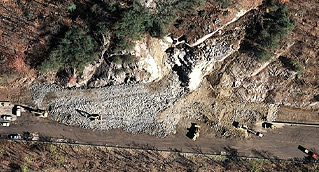 | asheville business & community directory |
|
This is an archived page that may contain outdated or incorrect information. Please visit www.Asheville.com for the latest news, events, and more.
 The Sikorsky helicopter hovers high above the mountain, gently moving the 1000-pound steel rod dangling below it from a wire rope. It inches this way, then that, positioning the 100-foot-long rock bolt over a 4-inch hole drilled deep into the slope.
The Sikorsky helicopter hovers high above the mountain, gently moving the 1000-pound steel rod dangling below it from a wire rope. It inches this way, then that, positioning the 100-foot-long rock bolt over a 4-inch hole drilled deep into the slope.The helicopter plays this rockslide version of threading the needle dozens of times each flying day as it ferries rock bolts used to stabilize the mountain. �It only takes the helicopter about five to seven minutes to install each bolt,� said North Carolina Department of Transportation project inspector Mike Patton. The helicopter started flying at noon today. Patton said he hopes to get 30 to 40 rock bolts into the ground, pushing the total to at least 310. Plans call for crews to install a total of 590 in order to stabilize the mountain. Before the helicopter arrived, crews spent the morning moving some pieces of heavy equipment off the mountain and rechecking previously drilled holes. �We drilled a lot of those holes a while ago so we have to recheck their depth to make sure they have fallen in,� Patton said. �Then we place a long tube into them and blow them out with compressed air.� Crews have now tested 75 of the 125 �tensioned� rock bolts installed in the mountain. The testing requires them to use a hydraulic jack to apply 186,000 pounds of tension to the bolt. All tests have been successful. Rock bolts now being installed use a �passive� system in which the mountain itself put the bolts under pressure.
Crews are expecting to make great progress this week by taking advantage of the first extended period of sunshine in months. The National Weather Service is predicting clearing skies tomorrow and then sunshine and daytime high temperatures in the 70s for the area at least through Saturday. This section of Interstate 40 near the Tennessee border has been closed in both directions since the rockslide occurred Oct. 25. NCDOT estimates that it will reopen I-40 by late April when work at the October rockslide site should be completed. About one mile of the westbound lane closest to the mountain will be closed until this summer to allow crews to complete the work � including the installation of rock bolts and anchor mesh � at five additional sites. Travelers still can reach Western North Carolina via I-40 from the east and I-26 to the north and south. Exits 20 and 27 on I-40 provide access to popular destinations west of Asheville. In Tennessee, exits 432 through 451 provide access to popular destinations in southeastern Tennessee. The detour route is 53 miles longer and is an additional 45 minutes to an hour driving time. Motorists traveling on I-40 West should take Exit 53B (I-240 West) in Asheville and follow I-240 West to Exit 4A (I-26 West). Follow I-26 West (a North Carolina Scenic Highway) to I-81 South in Tennessee. Take I-81 South and follow it back to I-40 at mile marker 421. Eastbound motorists should use the reverse directions. NCDOT reminds motorists to stay alert, follow instructions on the message boards on the highways, obey the posted speed limit, leave early and travel at non-peak times when possible. Plan ahead before driving by visiting the NCDOT Traveler Information Management System Web site at www.ncdot.gov/traffictravel/ or calling 511, the state�s free travel information line, for current travel conditions. For daily rockslide updates, please visit the NCDOT Web site at www.ncdot.gov and click on the I-40 rockslide daily news and information section. (Image provided by the North Carolina Department of Transportation.) Looking for more happenings in the area? Check out Asheville.com's comprehensive visitor center.
|
